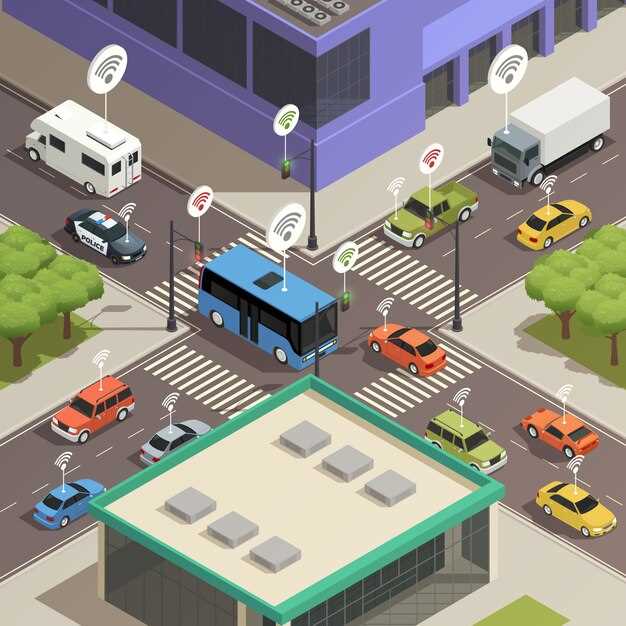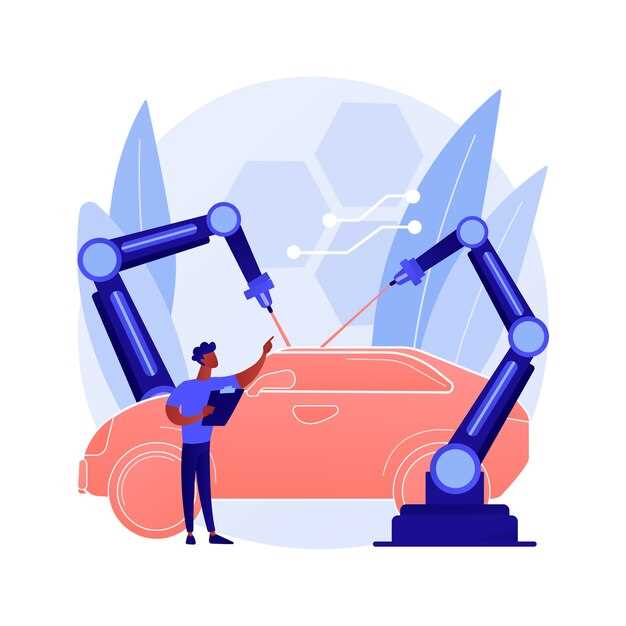Prioritize the integration of cutting-edge technology in road infrastructure to enhance safety and efficiency. Smart highways utilize real-time data and adaptive systems, allowing vehicles to communicate with roadway elements. This innovation significantly reduces congestion and lowers accident rates, creating smoother travel experiences.
Incorporate features like dynamic lane management and smart traffic signals, which adjust in response to traffic flow. Cities implementing these systems have reported a reduction in commute times by up to 30%. Investing in such technologies not only improves the commuter experience but also paves the way for environmentally friendly transportation solutions.
Engage with stakeholders to develop advanced monitoring systems using IoT devices. These sensors collect valuable data on traffic patterns and road conditions, allowing for proactive maintenance and immediate responses to potential hazards. As cities evolve their road networks, integrating smart technology will dictate the success of future urban mobility.
Integrating IoT Technologies in Highway Systems
Implement real-time traffic monitoring systems using connected sensors that gather data on vehicle speed, density, and road conditions. These sensors enhance traffic flow management by providing insights that optimize signal timings and reduce congestion. Such a system can lead to a 20% decrease in travel times based on studies from urban transport agencies.
Incorporate smart signage that communicates directly with IoT devices. This signage can update drivers about traffic conditions, hazards, or route changes instantaneously. For instance, dynamic message signs can adjust based on real-time data, improving safety and navigation.
Utilize vehicle-to-everything (V2X) technology to enable communication between vehicles, infrastructure, and pedestrians. By enhancing interoperability among vehicles and highway systems, V2X can prevent accidents and support autonomous driving initiatives. Integrating V2X can decrease accident rates by 30%, according to recent research.
Deploy predictive analytics leveraging collected data to forecast traffic patterns and events such as accidents or roadworks. Using machine learning algorithms can improve response times and resource allocation. Implementing predictive maintenance on roads and bridges based on sensor data reduces repair costs by up to 25%.
Invest in integrated payment systems where vehicles equipped with IoT devices can pay tolls automatically. This feature not only streamlines traffic flow but also maximizes toll revenue collection by reducing transaction times at barriers.
Establish partnerships with technology companies to ensure continuous updates and enhancements to the IoT ecosystem. Regular software updates should address vulnerabilities and optimize system performance, ensuring longevity and security.
| IoT Technology | Application | Benefits |
|---|---|---|
| Traffic Sensors | Real-time traffic monitoring | 20% reduction in travel times |
| Smart Signage | Dynamic information display | Improved driver awareness |
| V2X Communication | Vehicle and infrastructure interaction | 30% decrease in accidents |
| Predictive Analytics | Traffic pattern forecasting | 25% reduction in repair costs |
| Integrated Payment Systems | Toll payment automation | Smoother traffic flow |
Consider developing a robust cybersecurity framework to protect data and infrastructure from potential threats. A dedicated team should monitor traffic patterns and address anomalies swiftly, ensuring public safety and system integrity.
Stay informed about developments in IoT technologies and adapt highway systems to integrate new innovations. By prioritizing these strategies, road infrastructure can significantly enhance safety, efficiency, and user experience.
Benefits of Autonomous Vehicle Compatibility on Smart Highways
Integrating autonomous vehicles (AVs) with smart highways delivers multiple benefits that enhance safety, efficiency, and environmental sustainability.
- Increased Safety: AVs equipped with advanced sensors and communication systems significantly reduce the risk of accidents. They interact with smart infrastructure, receiving real-time data about traffic conditions, hazards, and road situations.
- Improved Traffic Flow: Smart highways incorporate traffic management systems that optimize vehicle movement. AVs can communicate with these systems, adjusting speed and routes to minimize congestion, leading to smoother traffic dynamics.
- Reduced Emissions: AVs promote eco-friendly transportation by optimizing driving patterns. Smart highways can provide guidance on the most energy-efficient routes, helping reduce fuel consumption and lower carbon footprints.
- Enhanced Mobility: Incorporating AVs in smart highway design increases access to transportation for various demographics, including the elderly and people with disabilities. This ensures that more individuals can utilize efficient travel options.
- Data-Driven Improvements: The interaction between AVs and smart infrastructure generates valuable data. Analyzing this data can lead to ongoing improvements in road design and traffic management, ultimately leading to safer and more reliable roadways.
Collaboration between automotive manufacturers and infrastructure developers is crucial to fully leverage these benefits. Ensuring that smart highways are designed with AV compatibility in mind will provide long-term advantages for cities, drivers, and the environment.
Real-Time Traffic Management Solutions for Urban Areas
Implement adaptive traffic signal control systems to optimize traffic flow. These systems adjust traffic light timings based on real-time vehicle counts and congestion levels, significantly reducing delays at intersections. Cities like Los Angeles have reported a 20% improvement in travel times after adopting these systems.
Integrate vehicle-to-infrastructure (V2I) communication technology to enhance connectivity between vehicles and traffic management systems. This implementation allows real-time sharing of traffic conditions, promoting smoother traffic flow and timely alerts for drivers. Cities with V2I systems experience fewer accidents and decreased congestion.
Utilize real-time traffic data analytics platforms to gather and analyze traffic patterns. Leveraging mobile apps and GPS data, urban planners can make informed decisions regarding road usage and maintenance needs. For instance, cities using analytics platforms can identify bottlenecks and deploy resources effectively during peak hours.
Incorporate smart parking solutions to manage demand for parking spaces. Real-time updates on available parking spots help drivers locate spaces more efficiently, reducing the time spent searching for parking. This has a direct impact on reducing traffic congestion, as seen in San Francisco with their innovative parking management systems.
Deploy an intelligent traffic management system (ITMS) that merges multiple data sources, such as weather conditions and public transport schedules, to create a holistic view of traffic conditions. This integration assists in optimizing emergency response routes and public transport efficiency, ensuring that urban mobility remains fluid.
Encourage community engagement through mobile applications that enable residents to report traffic issues. Crowdsourced data can help city planners identify problem areas quickly, allowing for faster responses and strategic improvements in infrastructure. This participatory approach builds a cooperative relationship between city officials and residents.
Implement dynamic message signs (DMS) along major roads to provide drivers with real-time information on traffic conditions, accidents, and alternate routes. These signs, combined with the other technologies mentioned, create a more informed driving environment that contributes to overall traffic efficiency.
Invest in research and pilot programs to test emerging technologies such as drone traffic monitoring. Drones can provide aerial views of traffic patterns, helping cities make rapid adjustments to traffic management strategies based on live observations.
By combining these solutions, urban areas can significantly reduce congestion, improve safety, and enhance the overall experience of road users. A proactive approach to traffic management not only improves daily commutes but also supports sustainable urban development.
Environmental Impact Reduction Through Smart Road Design
Implement advanced drainage systems to manage stormwater effectively. These systems prevent contamination and reduce flooding, protecting local ecosystems. Use permeable pavements that allow water to filter through, minimizing runoff.
Incorporate intelligent traffic management systems that optimize traffic flow. Reducing congestion leads to lower emissions. Adaptive signal control technology can adjust traffic lights based on real-time traffic conditions, enhancing vehicle movement and decreasing idle times.
Integrate renewable energy sources, such as solar panels embedded in road surfaces, to power streetlights and signage. This practice minimizes reliance on fossil fuels and promotes sustainable energy use.
Utilize lightweight materials in road construction. These materials decrease the overall carbon footprint of road systems and improve fuel efficiency for vehicles traversing these roads.
Implement green corridors with native vegetation alongside highways. These areas enhance biodiversity, provide habitats for wildlife, and improve air quality by absorbing pollutants.
Design roads with noise-reducing technology, such as sound barriers or absorptive road surfaces. This approach safeguards surrounding communities from traffic noise while enhancing the driving experience.
Promote multimodal transport by including dedicated lanes for bicycles and public transport. Encouraging alternative transportation reduces the number of vehicles on the road, leading to lower emissions and less congestion.
Adopt materials that reduce heat absorption, such as cool pavements and reflective surfaces. These features help mitigate the urban heat island effect, contributing to cooler local climates and lower energy consumption for air conditioning.
Encourage community involvement in road planning to ensure that local environmental concerns are addressed. Engaging local residents helps identify critical issues and fosters a sense of ownership in sustainable practices.
Monitor and analyze environmental impacts using data collected from smart sensors embedded in the roadway. This data aids in making informed decisions for future enhancements, ensuring continual improvement in sustainability efforts.
Cybersecurity Challenges in Smart Highway Infrastructure
Implement robust encryption protocols to protect data transmitted between vehicles and infrastructure. This prevents unauthorized access and ensures integrity in communications. Regularly update these protocols and conduct penetration tests to identify vulnerabilities.
Implement access controls using multifactor authentication for personnel managing the infrastructure. This deters insider threats and reduces the risk of unauthorized modifications to critical systems.
- Data Privacy: Safeguard personal information collected from vehicles. Implement strict data anonymization techniques and limit data retention to the minimum necessary for operations.
- Incident Response Plan: Develop and test a comprehensive response plan to manage cybersecurity breaches. Include clear protocols for communication, recovery, and assessment.
- Third-Party Security: Vet all third-party vendors rigorously. Ensure they adhere to stringent cybersecurity standards before integrating their technology into highway systems.
Monitor network traffic continuously for unusual patterns indicative of potential cyberattacks. Employ machine learning algorithms for real-time threat detection and automatic response capabilities.
- Conduct regular security audits of all systems and infrastructure components.
- Train staff on recognizing phishing attempts and best security practices.
- Establish a community of cybersecurity experts to share intelligence on threats and vulnerabilities.
Collaborate with government agencies and law enforcement for information sharing regarding emerging threats. This fosters a proactive approach to security in smart highway infrastructure.
Consider blockchain technology for securing data exchanges among connected vehicles and smart infrastructure, providing a transparent and immutable ledger that enhances trust.
Cost-Benefit Analysis of Upgrading Existing Road Networks
Investing in the upgrade of existing road networks offers a significant return on investment when evaluated through a cost-benefit lens. Upgraded roads lead to reduced vehicle operating costs, lower accident rates, and enhanced traffic flow efficiency. For example, improved road surfaces decrease vehicle wear and tear, saving drivers an estimated $0.05 to $0.10 per mile.
Analyzing safety metrics reveals that modern infrastructure, incorporating intelligent traffic management systems, can reduce accidents by up to 40%. The financial implications are substantial; for every $1 million spent on upgrades, communities can expect to see savings of approximately $6 million in accident-related costs over a decade.
On the environmental side, smart highways integrated with sensors and adaptive traffic signals can optimize vehicle flow, cutting emissions significantly. A study from the EPA indicates that efficient traffic management can lower carbon dioxide emissions by about 20%, translating to cleaner air and improved public health, which also reduces healthcare costs associated with pollution-related illnesses.
The initial investment in modernizing road networks often ranges from $500,000 to $2 million per mile, depending on the upgrades. However, long-term benefits include increased property values along improved corridors, which can appreciate by 10-20%. This uplift contributes to municipal tax revenue, partially offsetting the initial expenditure.
Incorporating technology, such as smart sensors and real-time data analytics, enhances maintenance schedules by predicting wear, effectively reducing long-term operational costs. Properly managed upgrades can extend the lifespan of road infrastructure by 20%, further stretching the initial investment.
Communities that embrace road network upgrades not only enhance mobility but also promote economic development. Businesses benefit from reduced delivery times and increased accessibility, which can lead to job creation and a broader tax base. Calculating the economic boost demonstrates that upgrading roads can enhance local economies by an estimated 3% to 5% annually.
Prioritizing strategic upgrades based on traffic studies and community feedback ensures targeted improvements. This approach maximizes benefits and aligns projects with specific regional needs, ensuring that investments yield the highest possible returns.






